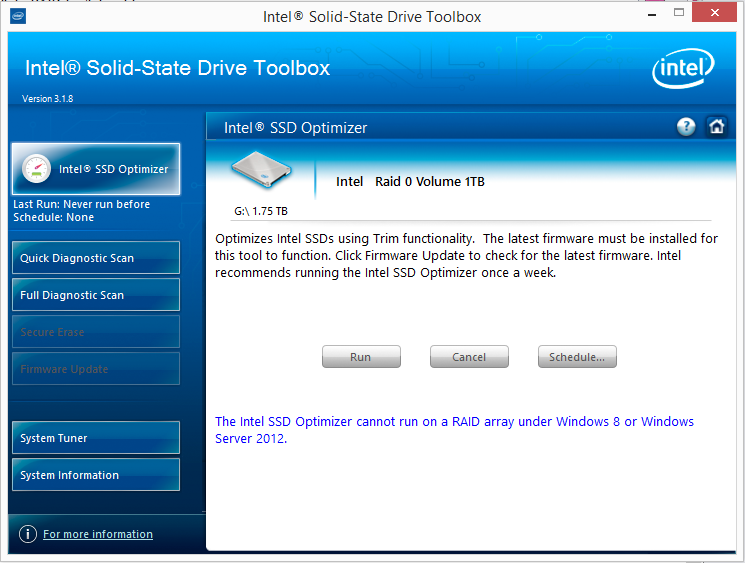Six SSD DC S3500 Drives And Intel's RST: Performance In RAID, Tested
Intel lent us six SSD DC S3500 drives with its home-brewed 6 Gb/s SATA controller inside. We match them up to the Z87/C226 chipset's six corresponding ports, a handful of software-based RAID modes, and two operating systems to test their performance.
Intel's Integrated Storage: New Hardware, New Software
Even enthusiasts are unlikely to round up six identical SSDs and drop them on a Z87- or C226-based motherboard. But it's nice to know that Intel makes this possible. While there were a lot of folks who felt stifled by the fact that previous-gen platform controller hubs only included two 6 Gb/s-capable SATA ports, a majority still stick with one SSD and one or more hard drives. That's the exact blend of storage we'd recommend, too.
The latest platforms do support six SATA 6Gb/s ports though, so it is possible to populate them with high-performance storage and realize some very impressive numbers from them. And why not? SSDs continue sliding in price. A sextet of 256 GB drives for under a grand would be pretty mind-blowing in a very high-end machine. Intel's integrated controller supports RAID 0, 1, 5, 10, so you have options for more throughput and data protection, depending on what you need.
Why not just drop a RAID controller into your Haswell-powered machine? For one, RoCs on add-in cards are not cheap. You could easily double the cost of your storage subsystem by going that route. Then there's the fact that any slot you use attached to the PCH is bound by the same DMI link, limiting bandwidth. Utilizing the processor's PCI Express connectivity automatically peels off at least eight lanes. In a small business server without discrete graphics, that's fine. But in a workstation where you're using a FirePro or Quadro card, it might not be. Just something to keep in mind. Besides, Intel's Rapid Storage Technology offers better performance at low queue depths, whereas high-end RAID cards are typically optimized for more outstanding commands.
ASRock's C226 WS is a great complement for a resilient file system like ZFS, which prefers when drives are presented directly to the operating system, rather than organized in a hardware-based RAID array. Software then manages striping, mirroring, and parity on its own. With six ports from Intel's PCH and four from Marvell controllers, that gives you a lot of options.
Based on our benchmark data, it looks like the best way to use Intel's integrated storage controller is with three high-performance SSDs. That's how you'll get the best bang for your buck in terms of performance scaling. With three 6 Gb/s ports open, you can then add a trio of hard drives for maximizing user data in RAID 5. Wait for 3 TB drives to go on sale, snag three trustworthy SSDs for RAID 0, and enjoy the best of performance, capacity, and value, all without the worry of a bottleneck along Intel's DMI.
The other good news is that, with multiple SSDs bumping and grinding on a Haswell-based system, you have support for the TRIM command in RAID 0. That's a big bonus. Intel's SSD Toolbox doesn't work under Windows 8 or Server 2012, but the new Windows Optimizer does (which is somewhat like the Intel Toolbox's forced-TRIM optimization).
Of course, Intel's SSD DC S3500 is a sexy beast in its own right, destined for more important roles than kicking out big numbers on a built-in storage controller. Although it doesn't match the S3700's endurance or consistency, it was designed to fill a different role. The S3500 employs the compute-grade flash that goes into Intel's latest desktop-oriented drives, meaning it isn't meant to take writes all day long. Rather, it's best suited to applications that push a ton of reads. In that environment, it does its job well, and for significantly less money than beefier SSDs with HET-MLC, eMLC, or SLC NAND.
Get Tom's Hardware's best news and in-depth reviews, straight to your inbox.
The SSD DC S3500s are also completely excellent in RAID. So much so, in fact, that I'm working on a follow-up to this piece. That's a story for another day, though.
Current page: Intel's Integrated Storage: New Hardware, New Software
Prev Page Mixing Block Sizes And Read/Write Ratios-
SteelCity1981 "we settled on Windows 7 though. As of right now, I/O performance doesn't look as good in the latest builds of Windows."Reply
Ha. Good ol Windows 7... -
vertexx In your follow-up, it would really be interesting to see Linux Software RAID vs. On-Board vs. RAID controller.Reply -
tripleX Wow, some of those graphs are unintelligible. Did anyone even read this article? Surely more would complain if they did.Reply -
utomo There is Huge market on Tablet. to Use SSD in near future. the SSD must be cheap to catch this huge market.Reply -
tripleX Wow, some of those graphs are unintelligible. Did anyone even read this article? Surely more would complain if they did.Reply -
tripleX Wow, some of those graphs are unintelligible. Did anyone even read this article? Surely more would complain if they did.Reply -
klimax "You also have more efficient I/O schedulers (and more options for configuring them)." Unproven assertion. (BTW: Comparison should have been against Server edition - different configuration for schedulers and some other parameters are different too)Reply
As for 8.1, you should have by now full release. (Or you don't have TechNet or other access?) -
rwinches " The RAID 5 option facilitates data protection as well, but makes more efficient use of capacity by reserving one drive for parity information."Reply
RAID 5 has distributed parity across all member drives. Doh!

